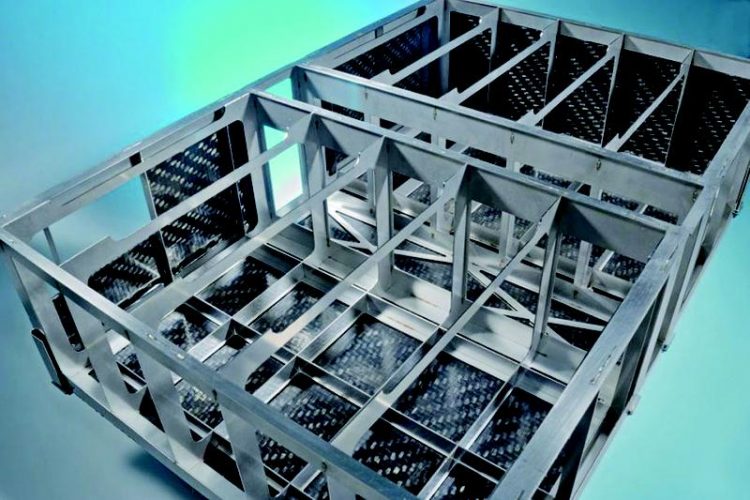Electromobility: Laser-Based Processes for Lightweight Battery Packs

Lightweight battery pack: a combination of high-strength steel and fiber reinforced plastic. © Fraunhofer ILT, Aachen
At the 66th International Motor Show IAA in Frankfurt, Fraunhofer ILT will be presenting the joint project »Fraunhofer System Research for Electromobility II« along with 16 other Fraunhofer institutes from 15 to 18 September 2015. Using the example of a »Lightweight Battery Pack« they will demonstrate to visitors how production technologies for lightweight construction can assist in storing the energy to power vehicles. They will be showing three different and partially complementary process technologies.
Laser-beam cutting and welding
For the processing of high-strength steel, it is important to avoid excessive thermal influence and, thus, material damage. Since they have such a small heat-affected zone, laser cutting and welding are particularly well suited here. In addition, these processes are economically more efficient than the traditional metal-cutting processes, since no material wear occurs.
“This process is already being used by Volvo. What is new here, however, is the combination of a plastic/metal compound for use in the car body, which we are presenting to the automotive industry for the first time. Thanks to the connection to the plastic, less steel is required in the application. Higher strength is achieved and the battery case is lighter. Through this process, we ensure that the industry can exploit the full potential of lightweight high-strength steel,” explains Dr. Alexander Olowinsky.
Joining plastic and metal
As an alternative to the conventional adhesive bonding of multi-material composites, Fraunhofer ILT will present a laser-based process of connecting simple semi-finished products, organic sheets, with metals such as high-strength steel. This process can, for example, be used in lightweight automotive construction as well as in the fields of mechanics and small components.
In the two-step method, a continuously emitting fiber laser at high speed first generates a microstructure in the metal. The structures have an undercut and are 30 µm wide and about 100 µm deep. In the subsequent joining step, the plastic is pressed against the structure and heated up to the molten phase of the matrix material. The matrix material then flows into the microstructures and locks into the undercut structures. The result: the connection is highly robust and an additive is unnecessary.
Reproducible and safe: oscillation welding for the electrical connection of battery cells
To construct complete battery packs, the Aachen researchers rely on oscillation welding with laser radiation. Here, individual battery cells (type 18650), which are normally used in power tools and notebooks, are welded together with copper contacts, therefore providing an electrical and thermal connection. The remarkable thing is that the joining at the negative pole also takes place from the top of the cell.
In a parallel circuit of 30 cells, a tight space between the battery cells is created by the design of the module and filled with PCM slurry (Phase Change Material, a mixture of paraffin and water). “By using the PCM, we are able to protect the battery cells thermally. This ultimately extends battery life,” says ILT researcher Benjamin Mehlmann. The use of laser-beam oscillation welding leads to a better control of the welding and, thus, a stable process. Moreover, the method is qualified and suitable for industrial mass production, for example, for the production of power tools.
Strengthening the German economy
Together, these three process technologies are especially suitable for the large-scale production of traction batteries for vehicles, for example, as the processes are highly automated and the energy input is easy to control. Since the market for these vehicles is steadily growing, this process development has a very promising future.
“In order to advance the battery production in Germany – currently most components are bought from abroad – our processes have to be automated, robust and less expensive. We are pleased that we can make a decisive contribution towards the production of lightweight battery packs and battery modules in Germany,” said Dr. Olowinsky.
Presentation of the lightweight battery packs at the IAA
What makes the lightweight battery pack special is that it is modular: the so-called traction batteries are suitable for hybrid vehicles as well as for use in electric vehicles with higher operating distances. Fraunhofer ILT is coordinating the subproject »Lightweight Battery Pack« within the »Fraunhofer System Research for Electromobility II«. The Fraunhofer Institute for Environmental, Safety and Energy Technology UMSICHT is managing the use of the PCM slurry for buffering the thermal energy.
The electric control and the battery management system have been developed by the Fraunhofer Institute for Solar Energy Systems ISE. The assessment of the plastic-metal compounds was carried out by the Fraunhofer Institute for Mechanics of Materials IWM, which used simulation and load tests to examine the mechanical design of the battery case.
First results of the crash tests as well as the entire demonstrator model of the lightweight battery packs will be shown at the joint Fraunhofer stand D33 in Hall 4.1.
Contact
Dipl.-Ing. Benjamin Mehlmann
Micro Joining Group
Telephone +49 241 8906-613
benjamin.mehlmann@ilt.fraunhofer.de
Dr. Alexander Olowinsky
Head oft he Micro Joining Group
Telephone +49 241 8906-491
alexander.olowinsky@ilt.fraunhofer.de
Fraunhofer Institute for Laser Technology ILT
Steinbachstraße 15
52074 Aachen, Germany
Media Contact
All latest news from the category: Trade Fair News
Newest articles

First-of-its-kind study uses remote sensing to monitor plastic debris in rivers and lakes
Remote sensing creates a cost-effective solution to monitoring plastic pollution. A first-of-its-kind study from researchers at the University of Minnesota Twin Cities shows how remote sensing can help monitor and…

Laser-based artificial neuron mimics nerve cell functions at lightning speed
With a processing speed a billion times faster than nature, chip-based laser neuron could help advance AI tasks such as pattern recognition and sequence prediction. Researchers have developed a laser-based…

Optimising the processing of plastic waste
Just one look in the yellow bin reveals a colourful jumble of different types of plastic. However, the purer and more uniform plastic waste is, the easier it is to…



